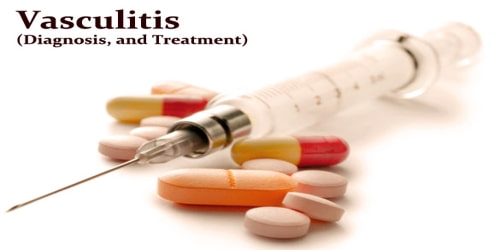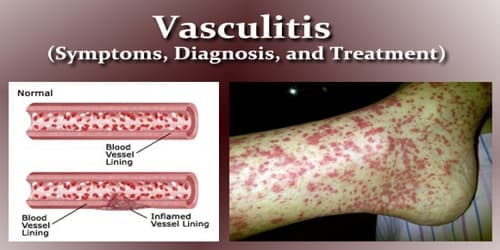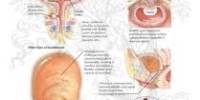Vasculitis (Symptoms, Diagnosis, and Treatment)
Definition: Vasculitis (also known as angiitis and arteritis) refers to a large group of diseases that cause inflammation of the blood vessels. Both arteries and veins are affected. It causes changes in the blood vessel walls, including thickening, weakening, narrowing or scarring. These changes can restrict blood flow, resulting in organ and tissue damage.
Vasculitis can be acute and short-term or chronic and long-term. In some cases the organs in the body may be affected, especially if they do not receive enough nutrient and oxygen-rich blood, resulting in organ damage, and sometimes death.
The word vasculitis is derived from the Latin “vasculum”, vessel + “- itis,” inflammation. Another term for vasculitis is angiitis. When arteries are the inflamed blood vessels, the condition is also referred to as arteritis. When the veins are inflamed, it is referred to as venulitis.
There are many types of vasculitis, and most of them are rare. Vasculitis might affect just one organ or several. The condition can be short-term (acute) or long-lasting (chronic).
Vasculitis occurs when the body’s immune system mistakenly attacks its blood vessels. Typically, when blood vessels are affected by vasculitis, they become inflamed. Researchers don’t know the actual cause of vasculitis; however, common features of the condition include inflammation of blood vessels and immune system abnormalities. Examples of diseases and conditions in which vasculitis occurs include:
- Kawasaki disease
- Behçet’s disease
- Polyarteritis nodosa
- Granulomatosis with polyangiitis
- Churg-Strauss syndrome
- Temporal arteritis (giant cell arteritis)
- Henoch-Schönlein purpura
Vasculitis can affect anyone, though some types are more common among certain groups. Depending on the type people have, people may improve without treatment. Some types require medications to control the inflammation and prevent flare-ups.

Signs and Symptoms of Vasculitis: The signs and symptoms of vasculitis vary greatly. They’re often related to decreased blood flow throughout the body. The symptoms of vasculitis vary greatly from person to person and depend upon the organs affected and the severity.
General signs and symptoms of vasculitis include:
- Fever
- A headache
- Fatigue
- Weight loss
- General aches and pains
- Night Sweats
- Rash
- Nerve problems, such as numbness or weakness
- Affecting the lungs can cause shortness of breath and cough.
- Affecting the heart can cause congestive heart failure.
- Affecting the brain can cause headaches, confusion, seizures, stroke, paralysis, numbness, and lightheadedness.
- Affecting the kidneys can cause kidney failure.
Complications can vary depending on the type of vasculitis. The following are the most common complications:
- Organ damage: Poor oxygen and nutritional blood supply to organs can lead to damage.
- Infections: These include serious and life-threatening conditions, such as pneumonia and blood infection (sepsis).
- Vision loss or blindness: This is a possible complication of untreated giant cell arteritis.
- Recurrence: Even if treatment is successful there may be recurrent episodes. Some people require long-term treatment.
A blood clot may form in a blood vessel, obstructing blood flow. Rarely, vasculitis will cause a blood vessel to weaken and bulge, forming an aneurysm (AN-yoo-riz-um).

Diagnosis and Treatment of Vasculitis: The primary care doctor or specialist will ask someone about their symptoms, medical history, and carry out a physical examination. The following diagnostic tests may be ordered as well:
- Blood tests
- Urine tests
- Imaging tests (X-rays, ultrasounds, CT scans, or MRI scans)
- Angiogram (An angiogram is an X-ray of the blood vessels)
The diagnosis of vasculitis is definitively established after a biopsy of involved tissue demonstrates the pattern of blood vessel inflammation. Examples of tissues used for biopsy include skin, sinuses, lung, nerve, and kidney. Depending upon the situation, an alternative to biopsy can be an X-ray test of the blood vessels called an angiogram, which can demonstrate characteristic patterns of inflammation in affected blood vessels.
Treatment for vasculitis depends on several factors, including what type of vasculitis the person has, the severity of their symptoms, their age, and their general health. Sometimes, as may be the case with Henoch-Schonlein purpura, the condition clears up without medical treatment.
Some people have initial success with treatment, then experience flare-ups later. Others may never see their vasculitis completely go away and need ongoing treatment.
Typically, cortisone-related medications, such as prednisone, are used. Additionally, other immune suppression drugs, such as cyclophosphamide (Cytoxan) and others are considered. Additionally, affected organs (such as the heart or lungs) may require specific medical treatment when the disease is active.
Sometimes, vasculitis causes a balloon-like bulge (an aneurysm) to form in the wall of a blood vessel. This bulge may need surgery. Blocked arteries also may require surgical treatment.
Information Source:
















